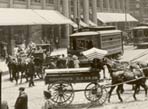
The Automobile Shapes The City
Introduction
Almost like a plough breaking the plains, the automobile transformed cities. “The car has reshaped the nation’s landscape,” an observer noted, “making it virtually unrecognizable from the unpaved version of the previous century.” Indeed, the transformation of American cities by motorized vehicles was a twentieth-century phenomenon, building upon the impact of transportation technology before it—especially the railroad and the streetcar—and leaving its own unique physical imprint. Some regarded this phenomenon as positive: the emergence of a private mass-transit technology effectively replacing public mass transit, and in doing so permitting settlement over a wide area and offering car owners the flexibility to “work, shop, and enjoy recreation” almost anywhere and at any time. To others, the swath cut through cities by the automobile undermined urban physical integrity, generated unending sprawl, and sabotaged the sense of community by emphasizing personal choice at the expense of the interest of the many.
Optimists and pessimists would agree, however, that the automobile was hardly a neutral force in urban physical development. To say that there had been congestion in central cities from the confluence of horses, carriages, bicycles, and streetcars for years prior to the introduction of the automobile does not mean the automobile’s impact on cities was not unique and profound; it simply reconfirms that transportation technology has always been a powerful force in making and remaking cities. But since the end of World War II especially, the car has shaped American cities and their suburbs so deeply that we can sometimes take its impact for granted.
Cars not only replaced rail service and a good deal of pedestrianism, but they strongly influenced inner-city growth in areas lacking any kind of transportation service and pushed the suburban boundaries outward “beyond the reach of the trolleys.” Rails had connected urban cores with their periphery before the automobile, but in a different way. Streetcar lines all converged downtown, radiating outward from the heart of the city. This centralizing orientation of the city ultimately was lost in most places because of the ubiquity of cars and trucks, which undermined such a familiar design.
City streets had usually followed the patterns of the streetcars and transportation routes before them, but it was only a matter of time before cars outgrew the limits of the old routes. The automobile initially had to function on a street system, according to historian John B. Rae, “that had never been designed for it and were about as poorly adapted to it as it was possible to be.” Furthermore, all other forms of transportation did not cease to exist once the automobile came on the scene. Motor vehicles—initially at least—had to share the streets and traffic patterns with trolleys, streetcars, carriages, wagons, bicycles, horses, and pedestrians, which were moving at varying speeds, took up more or less space, and served different needs.
Yet, as geographer Gabriel Dupuy has suggested, the success of the automobile in controlling streets and other urban space came down to its role as “a type of universal territorial adapter.” For one thing, the car was not simply a private form of transportation, but was largely dependent upon public support and public financing in the forms of government road construction, tax subsidies to oil and gasoline producers, favorable treatment to automobile manufacturers, and a variety of public taxing and bonding plans. In this sense, the use of cars and trucks redefined public and private responsibility for the dominant mode of transportation. Motorized vehicles also were the beneficiaries of a newly developing physical system of roads, streets, highways, and service and storage facilities, as well as a highly supportive body of consumers. In its own turn, the automobile system influenced access to numerous places for the driving community that had not been accessible before.
The “automobile system,” writ large, was not the result of serendipity, individual versus societal choices, or the product of chaotic effects on a helter-skelter landscape. Instead, the resulting system established its own rules and patterns, albeit different from the transportation systems that preceded it, but nonetheless possessing an internal order of its own. Ultimately, the automobile adapted its territory to a variety of living conditions and situations that existed in cities or reflected the interests of a driving public. As Dupuy concluded:
The acquisition of an automobile means simultaneously acquiring freedom of movement; having access, under all conditions and circumstances, to a variety of places which are frequently poorly accessed by public transport; maintaining a link with the countryside; transporting small children or the elderly; being able to go off for a week-end; leaving on vacation, carrying skis, pulling a trailer; etc. One might say that the decision to buy a car comes as a result of all these possibilities, providing a kind of insurance for unforeseen elements which might arise in the future.
Like other forms of transportation—possibly even more so—the automobile also helped to turn the landscape into real estate. Transportation always has played a central role in the location of human activities, especially dictating residence and work. Furthermore, vacant land connected by streets and roads and accessible by car often gained value and was thus commodified, which benefited landlords, bankers, realtors, contractors, and also an array of consumers. This has been a selective process, however, since room made for streets and highways, in particular, can cut into long established neighborhoods and communities even to a greater degree than recycling “undesirable” land uses.
<<Previous Section - Next Section>>
Introduction
The “Footprint” of the Automobile on the American City
From “Walking Cities” to “Automobile Cities"
Filling Stations and Other Services
Expressways, Freeways, and Superhighways
Complete Text Printable View
About the Project | Credits | Contact Us | Student & Teacher Resources | Site Map
©2004-2010 Automobile in American Life and Society
